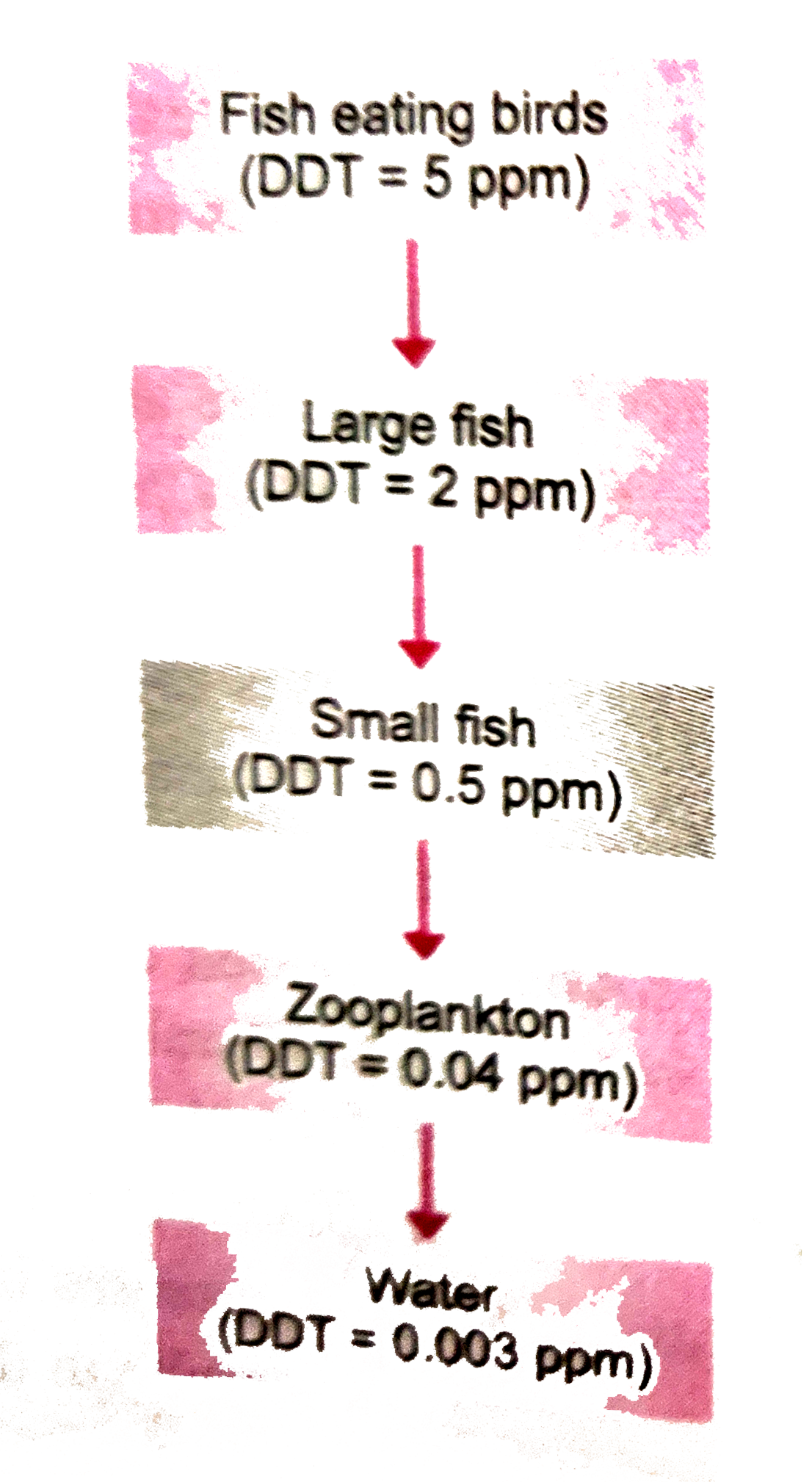In an aquatic food chain, if water is having 0.003 ppb of DDT can reach upto 25 ppm in
Large fish
Phytoplanktons
Fish eating birds
Small fish
The correct Answer is:C
To solve the problem regarding the concentration of DDT in an aquatic food chain, we will follow these steps:
Step 1: Understand the Initial Concentration
The initial concentration of DDT in water is given as 0.003 ppb (parts per billion).
Step 2: Convert ppb to ppm
To understand how this concentration can increase, we need to convert ppb to ppm (parts per million).
1 ppb is equivalent to 0.001 ppm. Therefore, to convert 0.003 ppb to ppm:
0.003ppb×0.001ppm/ppb=0.000003ppm
Step 3: Understand Biomagnification
Biomagnification is the process where the concentration of a toxic substance increases at each trophic level in a food chain. As organisms at lower levels are consumed by those at higher levels, the concentration of the toxicant accumulates.
Step 4: Identify Trophic Levels
In the aquatic food chain, the following trophic levels can be identified:
1. Phytoplankton (primary producers)
2. Small Fish (primary consumers)
3. Large Fish (secondary consumers)
4. Fish-eating Birds (tertiary consumers)
Step 5: Estimate Concentration at Each Trophic Level
As we move up the food chain, the concentration of DDT increases. The question states that it can reach up to 25 ppm in fish-eating birds. This indicates a significant accumulation through the food chain.
Step 6: Conclusion
Thus, starting from a concentration of 0.003 ppb in water, through the process of biomagnification, DDT can reach concentrations as high as 25 ppm in fish-eating birds, which are at the top of the food chain.
Summary
- Initial concentration of DDT in water: 0.003 ppb
- Conversion to ppm: 0.000003 ppm
- Through biomagnification, concentration increases at each trophic level, reaching 25 ppm in fish-eating birds.
---
The initial concentration of DDT in water is given as 0.003 ppb (parts per billion).
To understand how this concentration can increase, we need to convert ppb to ppm (parts per million).
1 ppb is equivalent to 0.001 ppm. Therefore, to convert 0.003 ppb to ppm:
0.003ppb×0.001ppm/ppb=0.000003ppm
Biomagnification is the process where the concentration of a toxic substance increases at each trophic level in a food chain. As organisms at lower levels are consumed by those at higher levels, the concentration of the toxicant accumulates.
In the aquatic food chain, the following trophic levels can be identified:
1. Phytoplankton (primary producers)
2. Small Fish (primary consumers)
3. Large Fish (secondary consumers)
4. Fish-eating Birds (tertiary consumers)
As we move up the food chain, the concentration of DDT increases. The question states that it can reach up to 25 ppm in fish-eating birds. This indicates a significant accumulation through the food chain.
Thus, starting from a concentration of 0.003 ppb in water, through the process of biomagnification, DDT can reach concentrations as high as 25 ppm in fish-eating birds, which are at the top of the food chain.
- Initial concentration of DDT in water: 0.003 ppb
- Conversion to ppm: 0.000003 ppm
- Through biomagnification, concentration increases at each trophic level, reaching 25 ppm in fish-eating birds.
Similar Questions
Biomagnification of DDT in an aquatic food chain starting from water having a concentration of 0.003 ppb may go, in fish eating birds, upto:
View SolutionThe range of biomagnification of DDT in an aquatic food chain, if starting from 0.003 ppb level in water may go at fish-eating bird level upto
View Solution
Knowledge Check
In an aquatic food chain, if water body is having 0.003 ppb of DDT, its maximum concentration can be observed in
ALarge fishBPhytoplanktonsCFish eating birdsDSmall fishBiomagnification of DDT in an aquatic food chain starting from water having a concentration of 0.003 ppb may go, in fish eating birds, upto:
A2 ppmB25 ppmC50 ppmD100 ppmConcentration of DDT for first trophic level (phytoplanktons) and top trophic level (fish eating birds) is respectively in aquatic food chains if DDT is 0.003 ppb in water is -
A0.999B0.003 ppm, 2 ppmC0.5 ppm, 2 ppmD0.04 ppm, 2 ppm
Find the correct order of bio magnification of DDT in an aquatic food chain
a) fish cating bird
b) water
c) zooplankton
d) small fish
e) large fish
View SolutionCreate an aquatic food chain in a water body into which effluents flow from a pesticide factory. Diagrammatically represent and answer the following questions :
(i) What is the phenomenon called? (ii) Explain biomagnification of pesticide.

View Solution1Lit. Of aq. Solution of urea having density=1.060gm/mL is found to have ΔTb=0.5∘C, if temp. of this solution increase to 101.5∘C then calculate amount of water which must have gone is vapour state upto this pt. given Kb=0.5Kkgmol−1 for water
View SolutionIn a certain study conducted on occurrence of DDT along food chains in an ecosystem, the concentration of DDT in grass was found to be 0.5 ppm (parts per million) in sheep it was 2 ppm and in man it was 10 ppm. Why was the concentration of DDT maximum in case of man ?
View SolutionIn an aquatic food chain polluted by DDT, the tissue concentration of DDT would be highest in
View Solution
